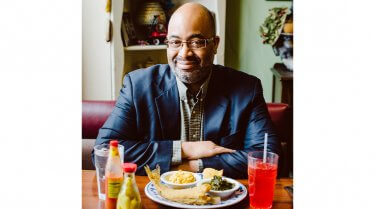Granted, it also brings to light the resilience — and ultimately, no small amount of pride — of the Black cooks, butlers and stewards who, over generations, managed the enormous pressures of not only pleasing the palates of the most powerful people in the world but meeting their nutritional needs while even, at times, protecting their egos. Take the kitchen staff of President William Howard Taft. As Miller recounts, “Taft was really into apple pie, but [he] was a hefty guy. One of the longest-running cat-and-mouse games in presidential history is the president usually arriving in office in not-so-great health, and it’s a stressful job, so they crave comfort food — but then you’ve got the first lady and the White House physician trying to keep the president on a diet.” Because neither happened to be accompanying him on a particular train ride from D.C. to Ohio, “when Taft was rolling out from the train station … he went to the person in charge of food and ordered an apple pie, and there was none available.” Or so they told him. “What he found out was that his staffers were basically hiding it from him. He played along with it, but eventually he got a slice.”
Or take Alonzo Fields, who served as a butler under four administrations. “In White House history, the butlers are usually the ones in charge of the drinks,” Miller explains. On Harry and Bess Truman’s first night in the White House, “[They] asked for an old fashioned, and so he makes it like he had been for presidents before, right? … [But] the next morning, First Lady Truman said, ‘Fields, can you make our old fashioneds less sweet? We’re just not used to having them that way.’ He’s like, ‘All right.’ He reconfigures the recipe; the next time they have one, Bess Truman takes a sip and says, ‘These are horrible. They taste like fruit punch.’ Now, Fields has an attitude, so the [third] time they ask for an old fashioned, he just gives [them] straight bourbon and two ice cubes. And Bess Truman takes one sip, looks at him, and says, ‘Now that’s how you make an old fashioned.’”
Be they comical or horrific, frustrating or inspiring, such personal anecdotes of the Black cooks and workers who have shaped American cuisine as we know it ground all three of Miller’s books — and one can only hope, works yet to come. Asked about topics he hopes to delve into in the future, he says, “The story of [19th century] African American street vendors is a cool story to tell. They … were such pictureqesue characters,” selling everything from pepper pot in Philadelphia to the rice fritters known in New Orleans as “calas.” “In Gordonsville, Virginia, there was a whole core of Black women who were known for selling fried chicken and pancakes at the train station. There was no dining car, so these women would just walk up and down the platform with these beautiful baskets of food; passengers would pay and then just reach out of their window to get it.”
Warming to the subject, he adds, “The cool thing is that I have the sheet music [and lyrics] for their street cries, so somebody who can read sheet music can replicate what somebody in the 1800s was hearing every morning. To put it to the universe, I’m hoping I can sign up Beyoncé and her pals for a companion musical piece.”
Given Miller’s accomplishments to date, we have no doubt the universe is listening.
Pedernales River Chili provided by Adrian Miller
- 2 tablespoons oil
- 4 pounds chili meat (coarsely-ground round steak or well-trimmed chuck or substitute Jennie-O® lean ground turkey)
- 1 large onion, chopped
- 2 cloves garlic
- 2 cups hot water
- 1 1/2 cups canned whole tomatoes
- 6 teaspoons chili powder, or more, if needed
- 1 teaspoon comino seeds or cumin
- 1 teaspoon ground oregano
- 2 to 6 generous dashes liquid hot sauce
Instructions
In large, heavy pot or Dutch oven over medium high heat, heat oil. Crumble turkey into saucepan. Add onion and garlic. Cook 14 to 16 minutes, stirring occasionally. Always cook to well-done, 165°F as measured by a meat thermometer. Add remaining ingredients. Bring to a boil. Reduce heat to simmer; cook 1 hour. Serves 12.

